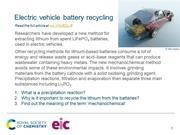New mechanochemical lithium extraction method is more environmentally friendly
Researchers in China have developed a mechanochemical method for extracting lithium from spent lithium iron phosphate batteries, widely used in electric vehicles. Current methods for recycling lithium-based batteries remain limited and have various drawbacks in terms of green chemistry. For example, pyrometallurgy may require a high reaction temperature and flue gas release. Hydrometallurgy requires acid–base reagents and may produce wastewater containing heavy metals.

The new method avoids some of these problems. The team manually separate the cathode, anode and plastic separator, then crush the cathode so any aluminium foil can be separated using a mesh screen. They then use mechanochemistry to treat the remaining cathode material powder with a solid-phase oxidant co-grinding agent, sodium persulfate.
Put this in context
Add context and highlight diverse careers with our short career videos showing how chemistry is making a difference and let your learners be inspired by chemists like Zubera, a research fellow in battery recycling.
Next, the team use water leaching and vacuum filtration to remove iron phosphate, followed by chemical precipitation to remove the lithium ions in solution in the form of lithium phosphate. Finally, they precipitate the remaining sodium sulfate in the solution and remove it via evaporation and crystallisation. By recovering each chemical product, the resulting wastewater can be recycled. The lithium phosphate generated can be resold at a profit to battery manufacturers.
Read the full story in Chemistry World.
Download this
rsc.li/3qJ2O5C
Downloads
Recycling lithium from batteries starter slide
Presentation | PDF, Size 0.18 mbRecycling lithium from batteries starter slide
Presentation | PowerPoint, Size 1.73 mb










No comments yet